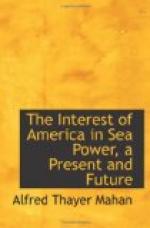[1] The Map of the Gulf and
Caribbean, p. 31, will serve
for geographical references
of this article.
The story of his actual achievement is sufficiently known to all readers, and need not be repeated here. Amid the many disappointments and humiliations which succeeded the brief triumphant blaze of his first return, and clouded the latter years of his life, Columbus was spared the pang of realizing that the problem was insoluble for the time. Like many a prophet before him, he knew not what, nor what manner of time, the spirit that was in him foretold, and died the happier for his ignorance. The certainty that a wilderness, peopled by savages and semi-barbarians, had been added to the known world, would have been a poor awakening from the golden dreams of beneficent glory as well as of profit which so long had beckoned him on. That the western land he had discovered interposed a barrier to the further progress of ships towards his longed-for goal, as inexorable as the mountain ranges and vast steppes of Asia, was mercifully concealed from his eyes; and the elusive “secret of the strait” through which he to the last hoped to pass, though tantalizing in its constant evasion, kept in tension the springs of hope and moral energy which might have succumbed under the knowledge of the truth.
It fell to the great discoverer, in his last voyage, to approach the continent, and to examine its shores along the region where the true secret of the strait lay hidden,—where, if ever, it shall pass from a dream to a reality, by the hand of man. In the autumn of 1502, after many trials and misadventures, Columbus, having skirted the south side of Cuba, reached the north coast of Honduras. There was little reason, except in his own unaccountable conviction, for continuing thence in one direction rather than in the other; but by some process of thought he had convinced himself that the sought-for strait lay to the south rather than to the north. He therefore turned to the eastward, though the wind was contrary, and, after a hard buffet against it, doubled Cape Gracias a Dios, which still retains its expressive name, significant of his relief at finding that the trend of the beach at last permitted him to follow his desired course with a fair wind. During the next two months he searched the entire coast-line as far as Porto Bello, discovering and examining several openings in the land which since have been of historical importance, among others the mouth of the San Juan River and the Chiriqui Lagoon, one of whose principal divisions still recalls his visit in its name, Almirante Bay, the Bay of the Admiral. A little beyond, to the eastward of Porto Bello, he came to a point already known to the Spaniards, having been reached from Trinidad. The explorer thus acquired the certainty that, from the latter island to Yucatan, there was no break in the obdurate shore which barred his access to Asia.




